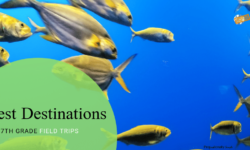The 7th grade puts your students in an interesting place. They are neither kids nor the "mature" high schoolers they so long to become, and will soon be. At this age, educational field trips are very important as a way of instilling education in a fun and different environment than the classroom. If you're here, chances are you already know this so let's get going and explore the following 7th grade approved field trip ideas!
Based on the general curriculum for American 7th-grade classes, the students will need extra time studying more than just the basics of art, science, math, and English. There's more of an emphasis on this grade level to learn about the variety of art forms from digital media and animation to classical art history; to delve deeper into math and explore both earth and space science, life sciences and physical science. You can, of course, find lessons in the smallest of things, such as taking a nature walk around the nearest park, but the following ideas are a little more focused.
Art Museums: As we said, the 7th grade brings with it many new experiences including newly opened doors in the humanities fields. Explore the full gamut of art at museums like the Metropolitan Museum of Art (The Met) in New York City, the largest in the United States and ranked among the top ten museums in the world for its fabulous and incomparable collections. Below are some more ideas on American art museums:
- The Walt Disney Family Museum - San Francisco: This incredible museum is also a wonderful history museum though it is based on Walt Disney's revolutionary animation techniques and the legacy he's left behind from his animation.
- Museum of Fine Arts Boston: Ranked as one of the best art museums in the country, MOFA Boston has an incredible selection and plenty of educational programs to lead your group through.
- de Young - Fine Arts Museum of San Francisco: This extension museum explores design in all of its glory. (P.S. If you're interested in fashion design, try the Garment District in New York City.)
Science Museums: Earlier we mentioned how important science is to 7th graders and that will be all the more clear with the following science-related destinations. Following the general curriculum, these science museums soar leaps and bounds above the others for their representation of earth and space science, life science, as well as physical science and engineering.
- California Science Center - Los Angeles: Amazingly educational and with free general admission (score!), this L.A. based science center is filled top to bottom with everything you're looking for. Exhibits range from space-related topics to ecosystems, biology, creative inventions and how the technology works, interactive exhibits to enhance learning, and even live shows.
- Museum of Science and Industry - Chicago: The single largest museum of its kind in the Western Hemisphere, the Museum of Science and Industry is a massive Hyde Park building with a mind-boggling collection of full-sized artifacts including a locomotive, a German U-boat, and a replica coal mine into which you can descend.
- St. Louis Science Center: St. Louis Science Center prides itself on being interactive. Here, your students will be able to explore the Life Science Lab and see living creatures, dig in the dirt with the Ecology & Environment regions, learn how to build an arch and other free-standing structures, and also Experience Energy. If you're in the Midwest, you can't go wrong with a trip to St. Louis.
- New Mexico Museum of Natural History and Science - Albuquerque: In New Mexico, we get an in-depth look at natural history and earth sciences. Here, you will find everything from dinosaur fossils and even a fossil lab to exhibits on evolution, and more. But not only can you explore the natural history of the planet, but you can also learn about the microcomputer and star constellations in the planetarium!
Cultural Interactions: As growing young people, your class will greatly benefit from varied cultural interactions where they will learn firsthand about different countries and customs. However, if you cannot travel overseas, there are cultural neighborhoods and internationally inspired cities right here in America.
- Chinatown - San Francisco: This is the most famous, largest, and most influential Chinatown in the United States, though there are others. It's also the oldest of the four Chinatowns in the city of San Francisco, the area has attracted a multitude of Asian immigrants. Whether it's history, entertainment, or food you seek, you'll find it in the bustling streets of Chinatown. (P.S. For a full-on cultural tour of San Francisco, also visit the Mission District and Japantown.)
- Little Italy - New York: Though the area started originally as purely a Little Italy, Manhattan's premiere cultural market neighborhood has since melded into several other areas including Chinatown, Nolita, and SoHo.
- Solvang, CA: Modeled to look and feel like the Danish capital of Copenhagen, Solvang is a cultural replica in the extreme. Explore Danish landmarks like a bust of Hans Christian Andersen and the Round Tower, as well as Danish bakeries, museums, and galleries.
Extra Field Trip Ideas:
- Amusement Park education days: Certain parks like Six Flags and Cedar Point offer education days where they close the park to regular visitors and groups of students have free reign. The catch is that they must do homework while they ride the rides. Physics problems to ride a roller coaster, geometry for the scrambler, and more. It works wonders for making homework fun.
- Living History attractions: They hear plenty of history in the classroom but what really drives names and events home for students is seeing it in person. Colonial Williamsburg and Jamestown Settlement are two of the most famous though there are living history parks based on pioneer days, Native American history, and more.
- Government: This is a gimme for all students, from the fourth grade on through high school. State, local, or federal, visiting the working branches of the government are an excellent way to instill lifelong learning and memories.
- Inventor History: Inventors like the Wright brothers, Ben Franklin, and Thomas Edison helped build the modern age as we know it. Visit their museums and historical parks to learn more about their contributions.







